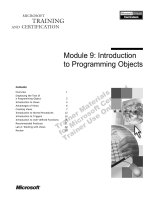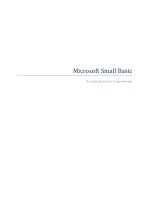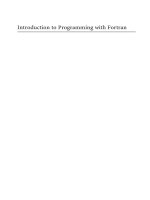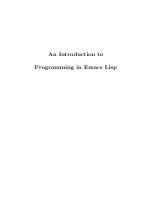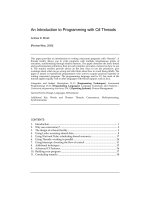Session 03 Introduction to Programming
Bạn đang xem bản rút gọn của tài liệu. Xem và tải ngay bản đầy đủ của tài liệu tại đây (362.05 KB, 40 trang )
LBC, Session 3
Operators, Expressions & Input/Output
FPT APTECH COMPUTER EDUCATION HANOI
Objectives
•
Operators and Expressions:
Expression definition
Classify arithmetic, relational, logical and binary
logical operators
Operator precedence
Assignment operator and Casting
• Input/Output in C
Formatted I/O functions : scanf()/printf()
Character I/O functions :getchar()/putchar(char c)
LBC/Session 3
2
Expressions
Combination of Operators and Operands
Operators
Example
2*y+5
Operands
LBC/Session 3
3
Operators
4 Types
Arithmetic
Logical
Relational
Bitwise
LBC/Session 3
4
Arithmetic Expressions
Mathematical expressions can be expressed in C using
arithmetic operators
Examples
++i % 7
5 * (c - 3 + d)
a * (b + c/d) - 22
LBC/Session 3
5
Relational & Logical Operators-1
Used to test the relationship between two variables, or
between a variable and a constant
Relational Operators
LBC/Session 3
6
Relational & Logical Operators-2
Logical operators are symbols that are used to combine or
negate expressions containing relational operators
Example: if (a>10) && (a<20)
Expressions that use logical operators return zero for false, and 1 for true
LBC/Session 3
7
Bitwise Logical Operators-1
Processes data after converting number to its binary
equivalent. (Bit wise representation)
AND
( NUM1 & NUM2)
Return 1 if both the operands are 1
OR
Returns 1 if bits of either of the
( NUM1 | NUM2 ) operand are 1
NOT
( ~ NUM1)
Reverses the bits of its operand
( from 0 to 1 and 1 to 0)
XOR
Returns 1 if either of the bits in an
( NUM1 ^ NUM2) operand is 1 but not both
LBC/Session 3
8
Bitwise Logical Operators-2
Example
10 & 15 1010 & 11111010 10
10 | 15 1010 | 11111111 15
10 ^ 15 1010 ^ 11110101 5
~ 10 ~1010 1011 -11
LBC/Session 3
9
Precedence Of Arithmetic Operators
Operator Class
Operators
Associativity
Unary
- ++ --
Right to Left
Binary
^
Left to Right
Binary
*/%
Left to Right
Binary
+-
Left to Right
Binary
=
Right to Left
LBC/Session 3
10
Precedence between comparison Operators
Always evaluated from left to right
LBC/Session 3
11
Precedence for Logical Operators
Precedence
Operator
1
NOT
2
AND
3
OR
When multiple instances of a logical operator are used
in a condition, they are evaluated from right to left
LBC/Session 3
12
Precedence among Operators
When an equation uses more than one type of operator
then the order of precedence has to be established with
the different types of operators
Precedence
Type of
Operator
1
2
3
Arithmetic
Comparison
Logical
LBC/Session 3
13
Precedence among Operators- cont.
Consider the following example:
2*3+4/2 > 3 AND 3<5 OR 10<9
The evaluation is as shown:
1)[2*3+4/2] > 3 AND 3<5 OR 10<9
2)[[2*3]+[4/2]] > 3 AND 3<5 OR 10<9
3)[6+2] >3 AND 3<5 OR 10<9
4)[8 >3] AND [3<5] OR [10<9]
5)True AND True OR False
6)[True AND True] OR False
True OR False
7)True
LBC/Session 3
14
Changing Precedence
Parenthesis ( ) has the highest level of precedence
The precedence of operators can be modified using
parenthesis ( )
In case of nested Parenthesis ( ( ( ) ) ) the inner most
parenthesis gets evaluated first
An expression consisting of many set of parenthesis
gets processed from left to right
Consider the following example:
5+9*3^2-4 > 10 AND (2+2^4-8/4 > 6
OR (2<6 AND 10>11))
LBC/Session 3
15
Changing Precedence (cont.)
The solution :
1) 5+9*3^2-4 > 10 AND (2+2^4-8/4 > 6 OR (True AND False))
The inner parenthesis takes precedence over all other operators
and the evaluation within this is as per the regular conventions
2)5+9*3^2-4 > 10 AND (2+2^4-8/4 > 6 OR False)
3)5+9*3^2-4 >10 AND (2+16-8/4 > 6 OR False)
Next the outer parentheses is evaluated
4)5+9*3^2-4 > 10 AND (2+16-2 > 6 OR False)
5)5+9*3^2-4 > 10 AND (18-2 > 6 OR False)
6)5+9*3^2-4 > 10 AND (16 > 6 OR False)
LBC/Session 3
16
Changing Precedence (cont.)
7) 5+9*3^2-4 > 10 AND (True OR False)
8) 5+9*3^2-4 > 10 AND True
9) 5+9*9-4>10 AND True
The expression to the left is evaluated as per the
conventions
10) 5+81-4>10 AND True
11) 86-4>10 AND True
12) 82>10 AND True
13) True AND True
14) True
LBC/Session 3
17
The Assignment Operator
The assignment operator (=) can be used with any valid C
expression
(Right value)
(Left value)
LBC/Session 3
18
Multiple Assignment
Many variables can be assigned the same value in a
single statement
However, you cannot do this :
LBC/Session 3
19
Type Conversion
LBC/Session 3
20
Casts
An expression can be forced to be of a certain type by
using a cast. The general syntax of cast:
(type) cast
type any valid C data type
Example:
float x,f;
f = 3.14159;
The integer value returned by (int)f
is converted back to floating point
when it crossed the assignment
operator.
The value of f itself is not changed.
x = (int) f; //The value of x will be 3 (integer)
LBC/Session 3
21
Standard Input/Output
• The standard library has functions for I/O that handle
input, output, and character and string manipulation
• Standard input is usually the keyboard
• Standard output is usually the monitor (also called the
console)
• Input and Output can be rerouted from or to files instead
of the standard devices
LBC/Session 3
22
The Header File <stdio.h>
•
#include <stdio.h> - This is a preprocessor
command
•
stdio.h is a file and is called the header file
• Contains the macros for many of the input/output
functions used in ‘C’
•
printf(), scanf(), putchar(), getchar() functions are
designed such that, they require the macros in stdio.h
for proper execution
LBC/Session 3
23
printf ()
•
Used to display data on the standard output – console
Syntax printf ( “control string”, argument list);
• The argument list consists of constants, variables,
expressions or functions separated by commas.
• The control string must always be enclosed within double
quotes. It consists of constants, variables, expressions or
functions separated by commas.
Text characters: printable characters
Format Commands: % sign + format code
Nonprinting Characters: tabs, blanks and new lines
LBC/Session 3
24
Format codes-1
Format
printf()
scanf()
Single Character
%c
%c
String
%s
%s
Signed decimal integer
%d
%d
Floating point (decimal notation)
%f
%f or %e
Floating point (decimal notation)
%lf
%lf
Floating point (exponential notation)
%e
%f or %e
Floating point ( %f or %e , whichever is
shorter)
%g
Unsigned decimal integer
%u
%u
Unsigned hexadecimal integer (uses
“ABCDEF”)
%x
%x
Unsigned octal integer
%o
%o
In the above table c, d, f, lf, e, g, u, s, o and x are the type
specifiers
LBC/Session 3
25
